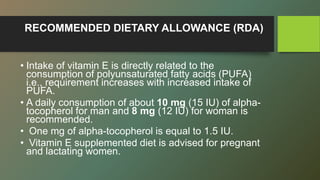VITAMIN E.pptx
- 1. VITAMIN E BY Dr SAI PRIYANKA NERUSU
- 2. INTRODUCTION • Vitamin E (tocopherol) is a naturally occurring antioxidant. It is essential for normal reproduction hence known as anti-sterility vitamin. • Evans and his associates (1936) isolated the compounds of vitamin E activity and named them as tocopherols • Evans and his associates (1936) isolated the compounds of vitamin E activity and named them as tocopherols • About eight • Tocopherols (vitamin E vitamers) have been identified Alpha, Beta, Gamma, Delta, etc. • Among these, Alpha-tocopherol is the most active. • The antioxidant property is due to the hydroxyl group of chromane ring.
- 3. ABSORPTION, TRANSPORT AND STORAGE • Vitamin E is absorbed along with fat in the small intestine. • Bile salts are necessary for the absorption. • In the liver, it is incorporated into lipoproteins (VLDL and LDL) and transported. • Vitamin E is stored in adipose tissue, liver and muscle. • The normal plasma level of tocopherol is less than 1 mg/dl.
- 4. Biochemical functions • Most of the functions of vitamin E are related to its antioxidant property. • It prevents the nonenzymatic oxidations of various cell components (e.g. unsaturated fatty acids) by molecular oxygen and free radicals such as superoxide (O2 –) and hydrogen peroxide (H2O2). • The element selenium helps in these functions. • Vitamin E is lipophilic in character and is found in association with lipoproteins, fat deposits and cellular membranes. • It protects the polyunsaturated fatty acids (PUFA) from peroxidation reactions. • Vitamin E acts as a scavenger and gets itself oxidized (to quinone form) by free radicals (R) and spares PUFA
- 5. BIOCHEMICAL FUNCTIONS OF VITAMIN E • Vitamin E is essential for the membrane structure and integrity of the cell, hence it is regarded as a membrane antioxidant. • 2. It prevents the peroxidation of polyunsaturated fatty acids in various tissues and membranes. It protects RBC from hemolysis by oxidizing agents (e.g. H2O2). • 3. It is closely associated with reproductive functions and prevents sterility. Vitamin E preserves and maintains germinal epithelium of gonads for proper reproductive function.
- 6. BIOCHEMICAL FUNCTIONS OF VITAMIN E 4.It increases the synthesis of heme by enhancing the activity of enzymes Delta- aminolevulinic acid (ALA) synthase and ALA dehydratase. 5. It is required for cellular respiration through electron transport chain (believed to stabilize coenzyme Q). 6. Vitamin E prevents the oxidation of vitamin A and carotenes. 7. It is required for proper storage of creatine in skeletal muscle. 8. Vitamin E is needed for optimal absorption of amino acids from the intestine. 9. It is involved in proper synthesis of nucleic acids. 10. Vitamin E protects liver from being damaged by toxic compounds such as carbon tetrachloride. 11. It works in association with vitamins A, C and Beta -carotene, to delay the onset of cataract.
- 7. BIOCHEMICAL FUNCTIONS OF VITAMIN E • Vitamin E has been recommended for the prevention of chronic diseases such as cancer and heart diseases • It is believed that vitamin E prevents the oxidation of LDL. (Note : The oxidized LDL have been implicated to promote heart diseases.) Vitamin E and selenium • The element selenium is found in the enzyme glutathione peroxidase that destroys free radicals • Thus, Se is also involved in antioxidant functions like vitamin E, and both of them act synergistically.
- 8. RECOMMENDED DIETARY ALLOWANCE (RDA) • Intake of vitamin E is directly related to the consumption of polyunsaturated fatty acids (PUFA) i.e., requirement increases with increased intake of PUFA. • A daily consumption of about 10 mg (15 IU) of alpha- tocopherol for man and 8 mg (12 IU) for woman is recommended. • One mg of alpha-tocopherol is equal to 1.5 IU. • Vitamin E supplemented diet is advised for pregnant and lactating women.
- 9. DIETARY SOURCES •Many vegetable oils are rich sources of vitamin E. • Wheat germ oil, cotton seed oil, peanut oil, corn oil and sunflower oil are the good sources of this vitamin. •It is also present in meat, milk, butter and eggs.
- 10. DEFICIENCY SYMPTOMS • The symptoms of vitamin E deficiency vary from one animal species to another. • In many animals, the deficiency is associated with sterility, degenerative changes in muscle, megaloblastic anaemia and changes in central nervous system. • Severe symptoms of vitamin E deficiency are not seen in humans except increased fragility of erythrocytes and minor neurological symptoms.
- 11. TOXICITY OF VITAMIN E •Among the fat soluble vitamins (A, D, E, K), vitamin E is the least toxic. • No toxic effect has been reported even after ingestion of 300 mg/ day for 23 years.
- 12. THANK YOU












